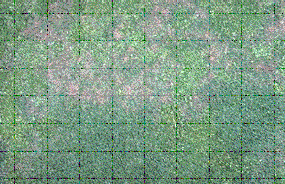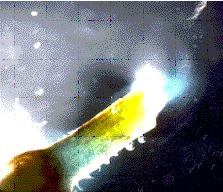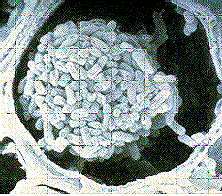Reports on Plant Diseases |
RPD No. 414 - Bacterial Wilt and Decline of Turfgrasses
|
October 1987
|
[ Symptoms ] [ Disease
Cycle ] [ Control ]
|
Bacterial wilt and decline is caused by the bacterium Xanthomonas pv. graminis.
The disease affects Toronto (C-15), Seaside, Nemisilla, and possible
other creeping bentgrasses, as well as annual bluegrass. Bacterial
wilt and decline occurs from late spring through summer and early
fall during warm, sunny weather. Infection and disease development
is favored by closely mowed turf and warm, sunny days with cool-to-warm
nights and heavy rainfall or watering.
The disease has been reported throughout Illinois and in many areas
of the United States where creeping bentgrass, especially Toronto,
is cultivated on golf greens. An antiserum recently prepared against
an Illinois isolate of the bacterium interacted with isolates from
Ohio, Michigan, and Wisconsin and with several X. campestris
pv. graminis isolates known to cause wilting and decline
of turf and forage grasses in Europe. This suggests that the bacterium
came to the United States from Europe.
Studies of forage grasses in Europe and New Zealand indicate host
grasses of the bacterium include perennial and annual (Italian)
ryegrasses, bluegrasses, tall and meadow fescues, orchardgrass,
timothy, quackgrass, and possibly others. Preliminary evidence in
the United States indicates that the bacterium may be adapting itself
to other grasses, such as bluegrasses.
Back to Top
|

Figure
1.
Toronto creeping bentgrass golf green heavily infected with bacterial
wilt and decline. Note the uneven mottled appearance.

Figure
2.
Close-up of withered and dead Toronto creeping bentgrass surrounded
by healthy, disease-resistant grass.
|
Symptoms
The leaves on individual plants start to wilt from the tip down.
Within a few days the entire leaf wilts, turns blue-green and becomes
shriveled and twisted. At this early stage, root and crown tissues
appear white and healthy. The leaves soon become reddish brown followed
by a discoloration of the roots and crown. Death and decomposition
of the entire plant soon follows. Symptoms of bacterial wilt and
decline can be confused with anthracnose, red leaf spot, and leaf
smuts.
The disease spreads through an infected golf green, killing susceptible
plants in just a few days, while apparently immune or highly resistant
grass cultivars and species remain unaffected. A diseased golf green
characteristically has an uneven mottled appearance with areas of
green, resistant grass among the withered and dead diseased turf
(Figures 1 and 2).
When a recently infected and freshly cut leaf or stem is examined
in a drop of water under a light microscope (at about 100X) a white
"cloud" of bacteria can be seen oozing from the cut surface
within a few seconds (Figure 3).
Back to Top
|

Figure
3.
A "cloud" of bacteria emerging from the cut end of a
grass stem infected with bacterial wilt.
|
Disease Cycle
The bacterium overwinters in diseased plants and thatch and is disseminated
by rain splash or flowing water, by physical transmission on mowers, hoses,
other turfgrass equipment, or shoes, and by planting infected sprigs,
sod, or plugs. The bacteria enter healthy grass plants through wounds
such as leaf tips cut by mowers. Originally, the bacteria are located
in leaf tissue but soon occupy the water-conducting vessels (xylem) in
the roots and crown where they quickly multiply. Masses of bacteria in
the vessels (Figure 4) prevent the normal movement of water within infected
plants causing them to wilt and die.
Back to Top

Figure
4.
Scanning electron microscoope photo of a xylem vessel in a grass
stem filled with Xanthomonas campestris pv. graminis bacteria
(courtesy Dr. D.L. Roberts).
|
Control
1. Chemical control. Disease reduction has been achieved
on Toronto creeping bentgrass greens using the antibiotic oxytetracycline
(sold as Mycoshield, C. Pfizer Corp). Preventative control appears
possible when the turf is drenched with antibiotic and at least
50 gallons of water per 1,000 square feet. Applications are needed
at 3- to 4-week intervals throughout the spring and fall when the
disease is active. Directions on the container label should be carefully
followed. Chemical control, however, is presently too expensive
and time-consuming to be practical over a long period of time.
2. Cultural control. The use of one or more resistant
cultivars (for example, Penncross or Penneagle) should eliminate
the need to apply repeated antibiotic drenches to susceptible turf.
The disease is usually most severe where the bentgrass is cut at
1/8 to 3/16 of an inch, less severe at 1/4 inch, and uncommon on
the collars of greens cut higher than 1/4 inch.
3. In the future, bacterial wilt and decline is likely to infect
other bentgrass cultivars as well as other species of turfgrass.
The best long-term solution to the problem is to use resistant turfgrasses;
however, none are presently being developed for use in the United
States.
The mention of a trade name or proprietary product does not constitute
warranty of the product and does not imply approval of this material
to the exclusion of comparable products that may be equally suitable.
Always read and follow the current package label instructions and
precautions.
|
Back to Top
|
For further information concerning diseases of crucifers
and other vegetables, contact Mohammad Babadoost, Extension Specialist in Fruit
and Vegetable Diseases, Department of Crop Sciences, University of Illinois at
Urbana-Champaign. University of Illinois
Extension provides equal opportunities in programs and employment.
|



